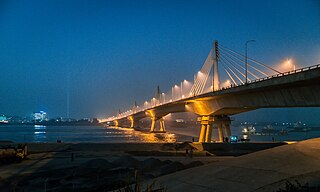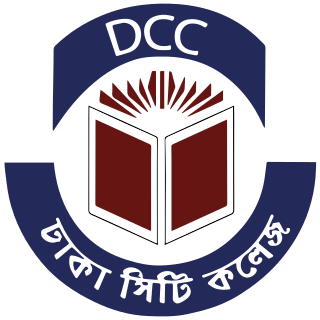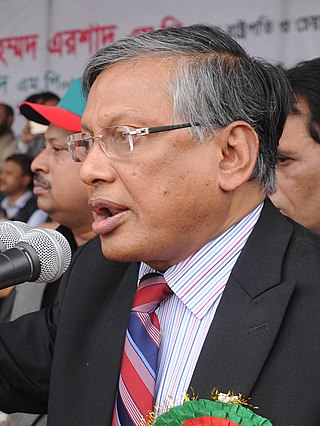
The Bangladesh Armed Forces are the military forces of the People's Republic of Bangladesh. They consist of the three uniformed military services: the Bangladesh Army, the Bangladesh Navy and the Bangladesh Air Force. The Armed Forces are under the jurisdiction of Ministry of Defence of the Government of Bangladesh, and are directly administered by the Armed Forces Division of the Prime Minister's Office. The President of Bangladesh serves as the Commander-in-Chief of the Bangladesh Armed Forces. Bangladesh has the third-largest defence budget in South Asia, The Bangladeshi military is the 37th strongest in the world and the third most powerful military force in South Asia. Border Guard Bangladesh and Bangladesh Coast Guard are under the jurisdiction of the Ministry of Home Affairs. during peacetime, but during wartime they fall under the command of Bangladesh Army and Bangladesh Navy respectively.

Sheikh Mujibur Rahman, popularly known by the honorific prefix Bangabandhu, was a Bangladeshi politician, revolutionary, statesman, activist and diarist. As a politician, Mujib had held continuous positions either as Bangladesh's president or as its prime minister from April 1971 until his assassination in August 1975. Mujib successfully led the Bangladeshi independence movement and restored Bengali sovereignty after over two centuries following the Battle of Plassey in 1757, for which he is honoured as the "Father of the Nation" in Bangladesh who declared independence. In the 2004 BBC opinion poll, Mujib was voted as the Greatest Bengali of all time.

Barisal Division is one of the eight administrative divisions of Bangladesh. Located in the south-central part of the country, it has an area of 13,225 km2 (5,106 sq mi), and a population of 9,325,820 at the 2022 Census. It is the least populous Division in Bangladesh. It is bounded by Dhaka Division on the north, the Bay of Bengal on the south, Chittagong Division on the east and Khulna Division on the west. The administrative capital, Barisal city, lies in the Padma River delta on an offshoot of the Arial Khan River. Barisal division is criss-crossed by numerous rivers that earned it the nickname Dhan-Nodi-Khal, Ei tin-e Borishal.

Chittagong, officially Chattogram, is the second-largest city in Bangladesh. Home to the Port of Chittagong, it is the busiest port in Bangladesh and the Bay of Bengal. It is the administrative seat of an eponymous division and district. The city is located on the banks of the Karnaphuli River between the Chittagong Hill Tracts and the Bay of Bengal. The Greater Chittagong Area had a population of more than 5.2 million in 2022. In 2020, the city area had a population of more than 3.2 million. The city is home to many large local businesses and plays an important role in the Bangladeshi economy.

Fazlur Rahman Khan was a Bangladeshi-American structural engineer and architect, who initiated important structural systems for skyscrapers. Considered the "father of tubular designs" for high-rises, Khan was also a pioneer in computer-aided design (CAD). He was the designer of the Sears Tower, since renamed Willis Tower, the tallest building in the world from 1973 until 1998, and the 100-story John Hancock Center.

The University of Chittagong is a public research university located in Hathazari, Chattogram, Bangladesh. It was established on 18 August 1966. It is one of the oldest universities in Bangladesh. Its 2,312.32 acres (935.76 ha) campus is the largest among universities in Bangladesh. It is one of the four autonomous by the act universities of Bangladesh.

Fazlul Quader Chowdhury was a Bengali politician who served as the 5th speaker of the National Assembly of Pakistan from East Pakistan. He belonged to Ayub Khan's Convention Muslim League. He was also the acting president of Pakistan from time to time when Ayub Khan left the country. His elder brother Fazlul Kabir Chowdhury was the leader of the opposition in East Pakistan assembly. Quader was preceded by Maulvi Tamizuddin Khan of Awami League.

The following outline is provided as an overview of and topical guide to Bangladesh:

Sheikh Azizur Rahman, known as Shawkat Osman, was a Bangladeshi novelist and short story writer. He won the Bangla Academy Literary Award in 1962, the Ekushey Padak in 1983 and the Independence Day Award in 1997.

Dhaka City College also known as DCC, is one of the oldest private colleges in Bangladesh. It is located at Qudrat-i-Khuda Road, Dhanmondi, Dhaka. It offers Honors and Masters degree programs as well as higher secondary education (HSC). The college is affiliated with the National University of Bangladesh.

Architecture of Bangladesh is intertwined with the architecture of the Bengal region and the broader Indian subcontinent. The architecture of Bangladesh has a long history and is rooted in Bangladesh's culture, religion and history. It has evolved over centuries and assimilated influences from social, religious and exotic communities. The architecture of Bangladesh bears a remarkable impact on the lifestyle, tradition and cultural life of Bangladeshi people. Bangladesh has many architectural relics and monuments dating back thousands of years.

Bashirul Haq was a Bangladeshi architect, town planner and visiting professor of MIT. He was regarded as one of the most influential architects in South Asia in terms of environmentally and socially responsive design.

Salman Fazlur Rahman commonly known as Salman F Rahman is a Bangladeshi businessman, and a former member of the Jatiya Sangsad representing Dhaka-1 constituency. He is notorious for his financial transgressions involving bank loans. He held the position of private industry and investment adviser to the former Prime Minister of Bangladesh, Sheikh Hasina, with the status of a cabinet minister. Prior to this, he was her private sector development affairs adviser. In 2017, he was ranked as the 1685th billionaires globally published by Beijing-based Hurun Gobal. He holds the position of vice chairman at BEXIMCO Group, one of the Bangladesh's largest conglomerates. He was the president of several trade bodies, including the Association of Television Channel Owners (ATCO). He is currently in the custody of Dhaka Metropolitan Police on the charge of instigating killing during the Bangladesh quota reform movement.

Sir Ahmad Fazlur Rahman, also known as A. F. Rahman, was a Bengali academic. He served as the first Bengali Vice-chancellor of the University of Dhaka during 1934–1936. He was knighted by the British Government of India in 1942.

Ziauddin Ahmed Bablu was a Bangladeshi politician of the Jatiya Party and served as the Secretary General for two terms. He was a Jatiya Sangsad member representing the Chittagong-9 constituency at the 10th Jatiya Sangsad and the Chittagong-6 constituency at the 4th Jatiya Sangsad. He served as the Cabinet Minister for Energy during Ershad's regime in the 1980s. He was appointed an advisor to the Prime Minister Sheikh Hasina in November 2013.
Fazlur Rahman was a Pakistani Bengali politician and lawyer. He was the first Education Minister of Pakistan and a member of the 1st and 2nd National Assemblies of Pakistan.
Rahul Quddus was a former bureaucrat of Bangladesh. He is the first and only secretary general of the Cabinet of Bangladesh and the first Principal Secretary of the Prime Ministers' Office.
















